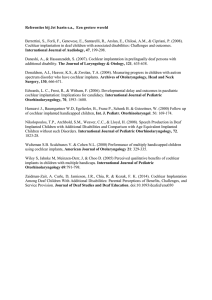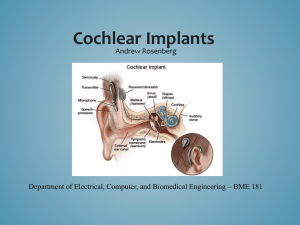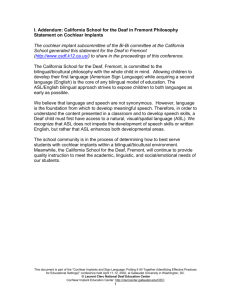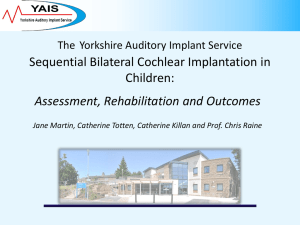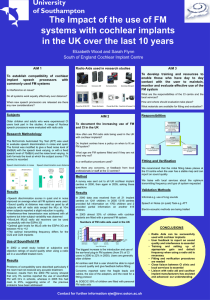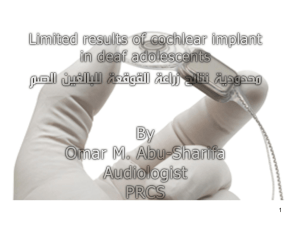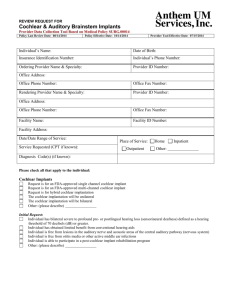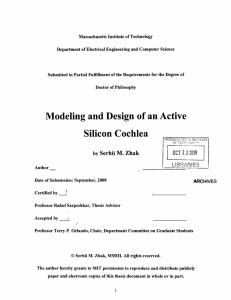Cochlear Implants
advertisement
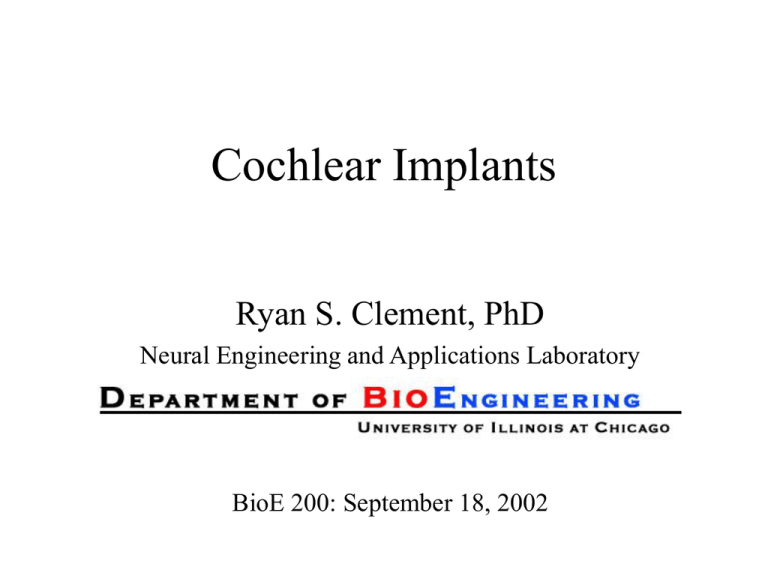
Cochlear Implants Ryan S. Clement, PhD Neural Engineering and Applications Laboratory BioE 200: September 18, 2002 Anatomy and Physiology of Hearing External Ear Middle Ear Bones Cochlea Ear Canal Ear Drum Adapted from: http://funsan.biomed.mcgill.ca/~funnell/AudiLab/501/mmem003.html Anatomy and Physiology (con’t) Cochlear Cross-section http://shark.me.nus.edu.sg/~asme/MechHear.htm Traveling Wave Movie ©Howard Hughes Medical Institute http://www.iurc.montp.inserm.fr/cric/audition/ Sound Transduction Cochlea Hair Cells Cochlear cross-section (single turn) Auditory Nerve Basilar Membrane http://www.iurc.montp.inserm.fr/cric/audition/ Sensorineural Hearing Loss OHCs IHCs • Causes – – – – – Microscopic view of hair cells. Heredity Genetic Aging process Ototoxic drugs Excessive exposure to loud sounds Electrical Stimulation Can Allow Us to Bypass Damaged Haircells A Brief History • Volta (1790) – metal rods and battery induced sounds like boiling liquid! • Djourno and Eyries (1957) – First demonstration of direct electrical stimulation of auditory nerve • House and Urban (1972) – Develop and test first prototype (single channel) – House/3M device gets FDA approval in 1984 A Brief History (con’t) • Clark, University of Melborne (1978) – Implant first multi-channel device – FDA approval in 1985 • From then till now: – continual improvements have been made in speech processing strategies and electrode design – Many patients can use the devices without the aid of lip-reading (even the telephone!) Safety Considerations • Biomaterials: • with the proper choice of materials there is no infection, just a minor fibrous sheath around the implant. • Electrode Insertion trauma: • factors: surgical technique, dimensions, array’s mechanical properties • If damage occurs to basilar membrane and dendrites, could lead to retrograde deterioration. However, are few and far between in most sensorineural hearing loss cases. • For most part damage is minimal. • Chronic Electrical Stimulation • Platinum electrodes: virtually no corrosion or depletion • Doesn’t destroy AN, in fact can help keep auditory nerve and cells in cochlear nucleus healthy (Leake et al 1992) • impedances and thresholds stabilize several days post implant Current Facts About Cochlear Implants Quick Facts: • candidacy: severe-to-profound sensorineural deafness Cochlear Corporation: NucleusTM •~70,000 recipients worldwide (~21,000 in the U.S.) * • 50% children (12 mo-17 years); 50% adults * • Manufacturers: FDA approved Cochlear Corporation: NucleusTM Advanced Bionics: ClarionTM Med-EL: Combi-40+TM AllHear: AllHearTM single channel Antwerp Bionic Systems: LauraTM (now owned by Cochlear) MXM Laboratories: DigisonicTM * FDA survey of venders 11/2001 http://www.nidcd.nih.gov/health/pubs_hb/coch.htm#c (The University of Melbourne) • Company founded by Dr. House http://www.allhear.com/ • Shorter insertion; claims to retain residual hearing in implanted ear • Single stimulation channel • Not yet approved for sale in United States Cochlear Corporation Speech Processors Contour • Company created out of Greame Clark’s work at the University of Melbourne, Australia • First FDA approved multichannel devices • 22 channels available for stimulation Advanced Bionics The Clarion II Implant • Based on work conducted at UCSF • Only American Company • 16 channels with 16 individual current drivers Med-El Corporation Processors Combi 40/40+ Implant • Headquarters in Austria • case for less signal loss and power consumption • 12 channels of stimulation Block Diagram for Typical Cochlear Implant System Skin Transmission Link mic Speech Proc. Encoder External Components Receiver/ Decoder Electrodes AN and Aud CNS Internal Components The Speech Signal “Never touch a snake with your bare hands.” Progression of Speech Processing Strategies Sound Input Speech Processing Electrical Stimulation Cochlear Frequency Tuning The cochlea is arranged such that different regions of the cochlea correspond to different pitches. Multichannel cochlear implants take advantage of this fact to encode different frequencies in the speech signal. Cochlear Electrodes Cochlear Corporation’s Nucleus Electrode Cochlea Cochlear Electrode Auditory Nerve What might cochlear implants sound like? • Cochlear implant simulations: – – – – – – Single channel 2 channels 3 channels 4 channels 6 channels 8 channels (created from Bob Shannon and Philip Lizou’s model) Dorman 2002 Scores on NU6/CNC words 100 90 Percent Correct 80 70 60 50 40 30 20 10 0 Med El CIS-Link Nucleus 22 Clarion v1.2 Nucleus 24 Clarion Hi-Focus C II Hi Res. Factors Effecting Cochlear Implant Performance • • • • • Duration of deafness Age of onset of deafness Age at implantation Duration of cochlear implant use Other: – Number of remaining auditory nerve fibers – Electrode placement and insertion depth – Dynamic range Future Research Directions • Better understanding of fundamental mechanisms • Better speech processing algorithms • Improved enjoyment of music • Electrode design improvements • Objective fitting for young children • Aesthetics (smaller, totally implantable) Cochlear Implant Research Team • Requires integration of many disciplines: – – – – – Bioengineering Physiology Otolaryngology Speech Science Signal Processing

